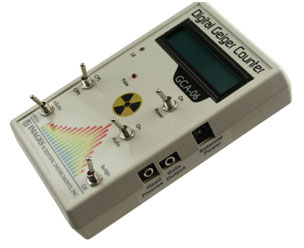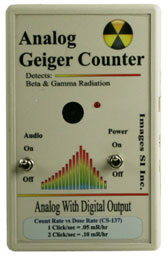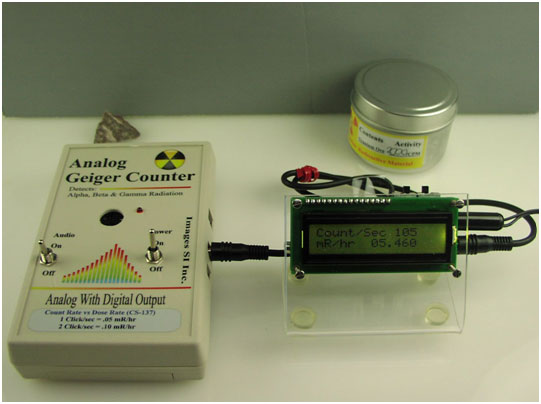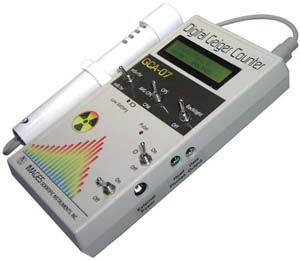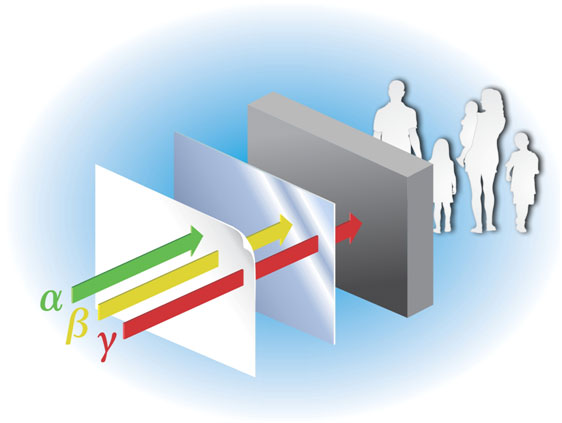
With so many Geiger counters available online, it's easy to become confused when comparing
specification and features to meet your needs. First, ask yourself, "why are you looking to buy a
Geiger Counter and what is your application?" Your answers to this question will refine your search
for a Geiger Counter model that will best satisfy your need.
Why other people purchase Geiger counters:
- Safety checks for radiation levels in your environment, home, food, water, and surroundings
- Anyone living close to a nuclear power plant.
- First responders who need a reliable and accurate Geiger counter.
- Interested in science and want to perform nuclear experiments?
- Survivalist being prepared for a nuclear accident or emergency?
- Gadget lover who wants to play with these instruments to satisfy your curiosity.
- Prospecting for uranium ore or radioactive materials is an interest.
- Collecting - checking vintage Fiestaware plates or glow-in-the-dark clock hands for radioactivity?
What is a Geiger Counter?
Before we look into features you need to look for in a Geiger Counter, let's first define what is a
Geiger counter. After all, you do not want to purchase an instrument that is not a Geiger Counter!
Geiger Counters are instruments that can detect and measure radioactivity using a Geiger Mueller
tube. Geiger Mueller tubes are commonly referred to as a GM tube tube. The original design of the
g-m tube by Hans Geiger and E.W. Mueller in 1928 hasn't changed much and the tube's sensor function
remains the same.
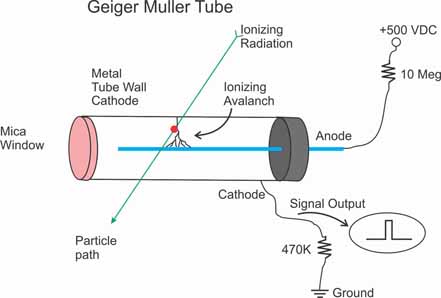
Radiation, as it passes through the GM tube, ionizes the gas within the tube. The ionization
initiates a momentary avalanche of electrons accelerate by the high voltage potential used to power
the GM tube. This avalance, create a momentary conductive path between the wire at the center of the
tube (Anode) and the wall of the tube (Cathode), see figure 1 resulting in a 'click' sound. By
measuring the number of the clicks, the instrument indicates the radiation levels.
The GM tube sensor is the heart of the Geiger counter and to be a Geiger counter, the device has to
contain a Geiger-Muller (GM) tube.
Nuclear radiation, what you need to know.
Nuclear Radiation
There are three primary radiation types associated with radioactivity.
Radioactivity is the spontaneous emission of energy from the nucleus of certain elements, most notably uranium. There are three forms of energy associated with radioactivity; alpha, beta and gamma radiation.
The classifications were originally made according to the penetrating power of the radiation, see figure 2
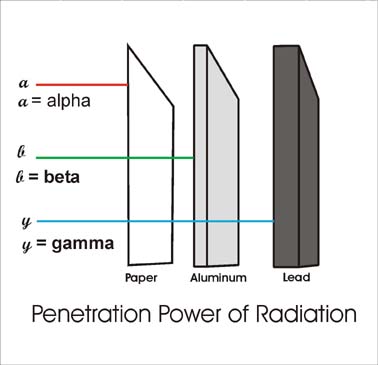
Alpha Particle Radiation were found to be the nuclei of helium atoms, two protons and two neutrons bound together. Alpha rays have a net positive charge. Alpha particles have the weak penetrating ability; a couple of inches of air or a few sheets of paper can effectively block them.
While alpha particles are stopped by a piece of paper, the situation changes once alpha radiation is inside the body, then the effects are more harmful than beta or gamma radiation. (See "Q" factor in testing food for radioactivity.) So materials that radiate Alpha particles are harmful if ingested or inhaled. But are not dangerous when external to the human body.
Beta Radiation were found to be electrons, identical to the electrons found in atoms. Beta rays have a net negative charge. Beta rays have a greater penetrating power than Alpha rays and can penetrate 3mm of aluminum.
Gamma Radiation and x-rays are high-energy electromagnetic radiation (high energy photons). This classification of radiation has the greatest penetrating power. High energy gamma rays are able to pass through several centimeters of lead and still be detected on the other side. Gamma rays are produced naturally from the decay of some radioactive materials.
X-rays on the other hand, is man-made radiation used in medicine and dentistry. While x-rays are man made electromagnetic radiation their frequency is so high that the radiation is also ionizing.
Natural Background Nuclear Radiation:
Nuclear radiation is a normal part of our life on planet Earth. We are bombarded with nuclear radiation every day. Background radiation, from natural sources on earth and cosmic rays will cause the Geiger counter to click randomly a number of times every minute. In my corner of the world I have a background radiation that triggers the counter 22-34 times a minute. When performing radiation checks to see if a material is radioactive or contaminated with radioactive material, this background radiation count is usually deducted from the reading to evaluate if a material is radioactive.
Geiger counters do not detect cell phone radiation. Do not detect radio frequency (RF) or electromagnetic field (EMF) radiation. EMF radiation is emitted from power transformers and other types of power electrical inductors. They cannot detect microwave radiation from a microwave oven. Nor can they detect neutrons.
Images Scientific Instruments has a free online radiation penetration calculator you can use. https://www.imagesco.com/geiger/cal/index.html
What Geiger Counters Do Not Detect:
Radiation Detection, the Geiger Muller (GM) Tubes
Geiger Muller Tubes
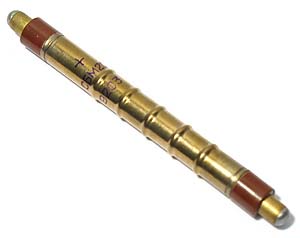
Inexpensive GM tubes like the SBM-20 Russian Geiger counter tube shown to the right, only detect beta, x-ray and gamma radiation. So if your Geiger counter uses one of these styles GM tubes it is blind to all alpha particle radiation.
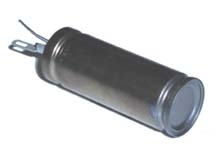 More expensive GM tubes, like the LND-712 Geiger Counter tube shown to the left have a thin mica window that allows alpha particle radiation to penetrate into the interior of the GM tube and ionize the gas for detection. It is generally more fragile than the beta-gamma GM tubes because of the thin mica window. The mica window allows one to detect the alpha radiation from radium and polonium. This type of Geiger counter may also be used for prospecting, experiments, and general field work. In addition, it can measure total radiation from materials including alpha radiation. Most laboratory grade Geiger counters use this style tube.
More expensive GM tubes, like the LND-712 Geiger Counter tube shown to the left have a thin mica window that allows alpha particle radiation to penetrate into the interior of the GM tube and ionize the gas for detection. It is generally more fragile than the beta-gamma GM tubes because of the thin mica window. The mica window allows one to detect the alpha radiation from radium and polonium. This type of Geiger counter may also be used for prospecting, experiments, and general field work. In addition, it can measure total radiation from materials including alpha radiation. Most laboratory grade Geiger counters use this style tube.
The common thread connecting the types of radiation these geiger counter tubes detect is that the radiation are all ionizing radiation. Meaning they are capable of ionizing the gas atoms inside a GM Tube which allows for their detection, as explained on page 1.
Ebay Geiger Counters and Radiation Detection
Used Pre-Owned GCA-07W Geiger Counters Available for Sale.
Ebay Geiger Counters
EBAY
is a place to find used and surplus Geiger Counters. If you search on ebay for Geiger counters, radiation detectors or radiation monitors you will run across numerous radiation detection devices. Let's look at a few. There is a lot of government surplus for sale on ebay. The CD-715 model is a popular model, see figure 3.
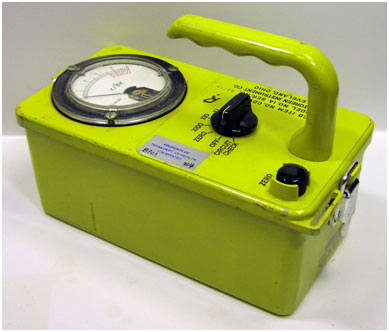 These detectors were made to be used in a high radiation field one would find in a post nuclear attack or nuclear reactor incident. The radiation meter provides the scale of detectable radiation, see figure 4.
Figure 4
The meter scale of the CDV-715 is rated in rads/hr. A knob provided a range of 0.1 - 0.5 Rad to 100 - 500 Rad's. Today's Geiger counters are far more sensitive, and measure radiation in fractions of millirads. A millirad is 1/1000 of a rad. The CDV-715 is not a Geiger counter. It doesn't have a GM tube, instead it uses an ionization chamber.
If you open a CDV-715 you can see the ionization chamber, see figure 5.
These detectors were made to be used in a high radiation field one would find in a post nuclear attack or nuclear reactor incident. The radiation meter provides the scale of detectable radiation, see figure 4.
Figure 4
The meter scale of the CDV-715 is rated in rads/hr. A knob provided a range of 0.1 - 0.5 Rad to 100 - 500 Rad's. Today's Geiger counters are far more sensitive, and measure radiation in fractions of millirads. A millirad is 1/1000 of a rad. The CDV-715 is not a Geiger counter. It doesn't have a GM tube, instead it uses an ionization chamber.
If you open a CDV-715 you can see the ionization chamber, see figure 5.
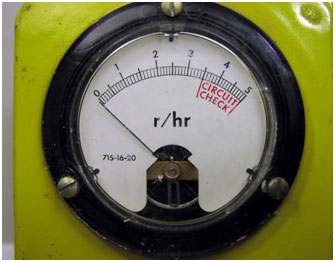
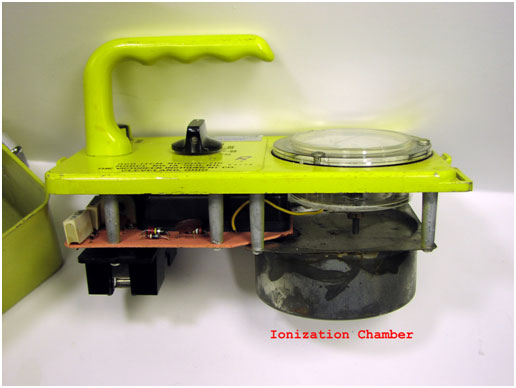
The CDV-715 only detects high levels of gamma radiation, so I would not recommend this as a purchase.
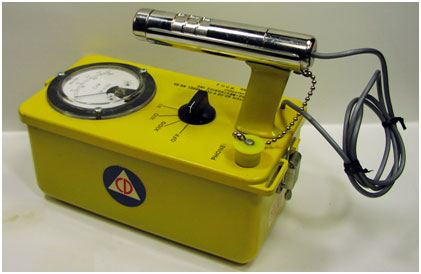
Similar is the CDV-700, which looks similar, but uses a GM tube, see figure 6.
The CDV-700 is more sensitive than the ionization chamber CDV-715. The CDV-700 meter shows the scale, see figure 7.
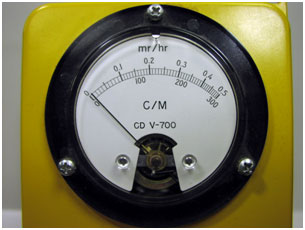 Figure 7
The GM Tube on the CDV-700 is only beta and gamma sensitive. Since most of these units are vintage 1950-1960's I do not have any idea as to their accuracy or if they can be calibrated accurately. Now if your only reason is to purchase a working Geiger counter and can find a working unit for $50-$75.00 buy it. When you reach the $100.00 mark you can purchase an inexpensive modern Geiger Counter that has greater sensitivity.
Figure 7
The GM Tube on the CDV-700 is only beta and gamma sensitive. Since most of these units are vintage 1950-1960's I do not have any idea as to their accuracy or if they can be calibrated accurately. Now if your only reason is to purchase a working Geiger counter and can find a working unit for $50-$75.00 buy it. When you reach the $100.00 mark you can purchase an inexpensive modern Geiger Counter that has greater sensitivity.
Used Pre-Owned GCA-07W Geiger Counters Available for Sale.
Geiger Counter Accuracy and NRC Certification
Geiger Counter's Nuclear Radiation Readout Accuracy
Two basic types are analog and digital. The digital Geiger counter is typically more accurate as you can obtain an exact count of radioactive particles detected. Where as the analog meters average out reading, and do not provide a display for the detected particle count. A digital readout from the GCA-06W is shown in figure 8 below.
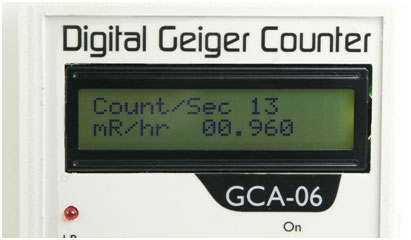 While many Geiger counter manufacturers claim high accuracy for their Geiger counter, it simply is not true.
While many Geiger counter manufacturers claim high accuracy for their Geiger counter, it simply is not true.
It is not enough to say an instrument is calibrated, or has an accuracy of 1%, 5%, 10%, or 20% because without a legitimate standard calibration reference, a claim of accuracy is meaningless.
Fortunately, there is a government approved Geiger Counter calibration standard, it is the ANSI-STD N323A. Passing this calibration standard certifies the accuracy of your Geiger counter instrument. The ANSI-STD N323A calibration should only be performed by a government licensed nuclear laboratory conforming to the Nuclear Regulatory Commission (NRC) regulations 10-CFR-34 and 10-CFR-35.
Without passing the ANSI-STD N323A calibration by a licensed lab, you cannot be sure of any claim that a Geiger counter accuracy is valid. Below is a picture of a calibration label for one of our Digital Geiger Counters. After passing ANSI-STD N323A calibration, a certification label is attached to the Geiger counter and this certification is valid for one full year.
When you purchase an NRC Certified Geiger counters from Images SI Inc., your Geiger counter has passed ANSI-STD N323A calibration using an NIST traceable source from licensed laboratory conforming to NRC regulations 10-CFR-34, 10-CFR-35.
Before you buy, ask if their Geiger Counter is ANSI-STD N323A calibrated using a NIST traceable source? If not, their Geiger counter probably can not pass ANSI-STD N323A calibration using an NIST source from an independent lab conforming to NRC regulations 10-CFR-34, 10-CFR-35. But if a seller claims the ANSI-STD N323A calibration is expensive and is not necessary. Ask, "If I send your Geiger counter for calibration to ANSI-STD N323A standards using a NIST traceable source will it pass? And more importantly, if it fails calibration, can I return the Geiger Counter for a full refund?" The seller's answer will tell you what you need to know to make a sound purchasing decision.
Without this ANSI N323A calibration, there is no reference point, to make a claim that the Geiger Counter accuracy is valid.
Below figure 9 is a picture of a
Calibration certification label for the GCA-07W
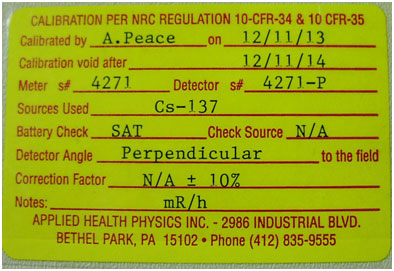
* All digital Geiger counters sold by Images SI Inc. can be NRC certified to their accuracy.
Where to Obtain ANSI N323A Calibration:
There are a number of independent laboratories that are licensed by the U.S. Government to test Geiger counters for their accuracy, and if it is accurate provide an Calibration certification label attached the Geiger Counter. The certification is good for one-year.
The laboratory my company uses is:
Applied Health Physics Inc.
2986 Industrial Blvd.
Bethel Park, PA 15102
(412) 835-9555
Geiger Muller (GM) Tubes, Internal Tube vs External Probes
GM Tubes: Internal or External: In the internal Geiger Counter instrument, the Geiger-Mueller tube is inside the case, enabling one hand operation, leaving the other hand free. Figure 10 shows the GCA-06 internal model.
For the external instrument, the tube is located outside the case at the end of a probe or wand and connected to the instrument via a cable, see figure 11.
Figure 11 shows the GCA-06W with an external probe/wand. This kind of instrument is more suited for ‘probing’ radiation levels in tight spots. It's easier to move a probe around to check for radiation, then it is to move the entire instrument.
How to read a Geiger Counter
How to read a Geiger Counter
The Geiger counter measures the radiation levels in different ways. Analog meters can provide a reading in Counts Per Minute (CPM) and their equivalent Radiation Level. For example lets look at the meter face to a common analog Geiger counter, see figure 12.
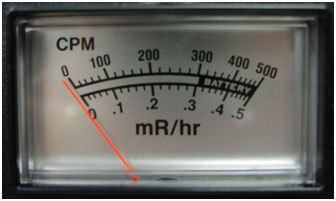 At its most sensitive scale a count of 500 CPM is equivalent to a radiation level of 0.5 mR/hr. This model Geiger counter has a 10X and 100X switch to select ranges from 0.5 mR/hr to 5 mR/hr and 50 mR/hr respectively.
At its most sensitive scale a count of 500 CPM is equivalent to a radiation level of 0.5 mR/hr. This model Geiger counter has a 10X and 100X switch to select ranges from 0.5 mR/hr to 5 mR/hr and 50 mR/hr respectively.
To obtain the Counts Per Second (CPS) divide the CPM by 60. So a CPM reading of 300 is equal to 5 CPS (300/60 = 5).
Digital Geiger Counters
Digital Geiger Counters have a digital display. The digital display has a number of advantages, such as providing an accurate and exact count of the detected radioactive particles in either the CPS or CPM measurement and their equivalent radiation level. The analog display approximates the number of clicks per minute.
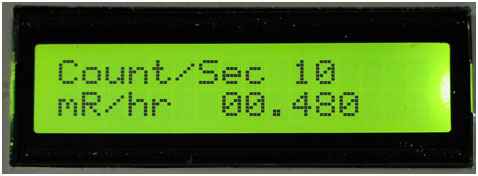
Figure 13 shows a digital display from a GCA-07, the Counts Per Second (CPS) on the top line of the LCD. The second line shows the equivalent radiation level. This second line's equivalent radiation level is a running three second average. This three second average smooths out the reading so it's not jumping every second in response to the changes in the CPS.
Imperial or Metric Measurement(s)
The digital display also allows you to change from Imperial measurements (mR/hr) to Metric measurements (mSv/hr) with a flip of a switch. Figure 14 shows a digital display from a GCA-07, the Counts Per Second (CPS) on the top line of the LCD as before. The second line shows the equivalent radiation level using metric measurements of mSv/hr. This second line's equivalent radiation level is also a running three second average, as explained before.
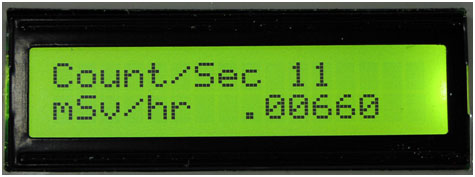
Figure 14
Switch from Imperial to Metric Measurements
CPM Measurments:
When switching to the CPM mode the digital screen changes, see figure 15.

Figure 15
The first LCD line shows the running timer. The timer starts at 0 seconds and counts to 60 seconds (one minute). Next to the elapsed time on the first line is the accumulated count of radioactive particles detected. The timer continues to count radioactive detections until a full minute (60 seconds) has passed. At the point the display pauses for one-second to show the complete count for the minute and its relative radiation level before resetting the timer and accumulated count to zero and starting to count for the next minute.
The second line shows will continue to show radiation level until it updates again at the end of the minute.
One can also switch from Imperial measurement uR/hr to metric measurement uSv/hr in CPM mode.
Ranges and Data Loggers
Range:
The range of your Geiger counter tells you how much radiation you can measure. Typically analog meter Geiger counters range from 1 to 100 mR/hr. Although some can go as high as 500 mR/hr. With digital Geiger counters the typical range is 1 to 200 mR/hr. However the GCA-06 and GCA-07 series of digital Geiger counters range from 1 to 1000 mR/hr and maintain their NRC accuracy.
Data Logging / Software:
Does your Geiger Counter come with data logging or radiation charting software?
The radiation charting software allows one to chart radioactivity over long periods of time. It allows radiation data to be saved in files and pulled up into other programs like excel. The radiation charting software for Images SI Inc. is shown in Figure 18.
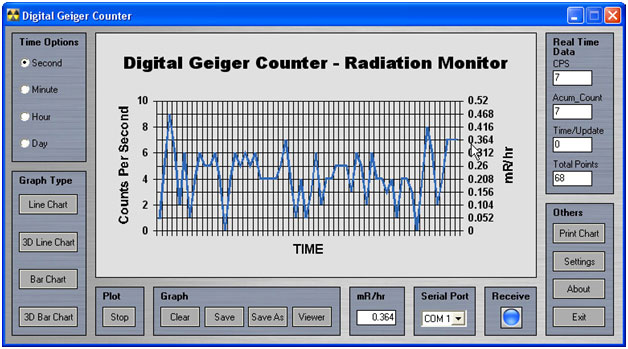
This radiation charting and monitoring software is free for downloading from Images SI Inc. website for any compatible Geiger counter. Go here.
Data Loggers - Digital Output
Modern Geiger Counter usually has a digital outputs that outputs a +3-5V pulse with each detection of a radioactive particle. A suitable Data logger that logs TTL +5 pulses is shown in figure 19.
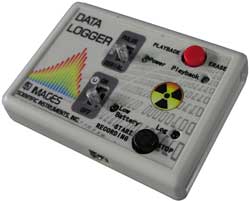
For anyone interested in data loggers you need to look for in a data logger that counts events. Setting up this data logger is simple. Install the program and USB driver on your PC. Install the battery (provided) in the EL-USB-5. Plug the data logger into a free USB port. Run the installed program.
Connecting the Data Logger to the Geiger Counter.
This particular Data logger is connected to a Geiger counters digital output pulse via a 3.5 mm jack. So we can make a simple interface using a 3.5 mm cable from the Geiger counter to Datalogger.
Once your data are recorded, you reconnect the Logger to the computer and save the recorded test data using the Geiger Graphing Software. I recorded 298 minutes of background data from a GCA-07. The instructions to import the text data into an Excel spreadsheet are provided in the Data Logger instructions. Once the data is inputted into Excel it can be manipulated and graphed, see figure 20 below. The average Count Per Minute (CPM) was 16 with a minimum count of 6 CPM and a maximum of 28 CMP.

Digital Meter Adapters - Working Within a Budget:
Plain vanilla Geiger counters that have a pulse output can be brought into the Digital age using a Digital Meter Adapter (DMAD). To work properly, the Geiger counter must output a pulse for every radioactive particle it detects. The GCA-01 shown in figure 21, is an inexpensive Geiger counter that may be purchased for under $100.00 as a kit or for $129.95 assembled and tested.
The DMAD Adapter may be used with any Geiger Counter that outputs a TTL Digital pulse for each radioactive particle detected. Since the DMAD is a general device, the radiation conversion may not be exact since different GM tubes have different responses to radiation. The CPS or CPM counts will be exact.
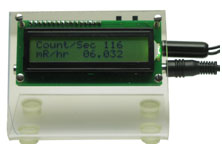
The DMAD may be purchased as a kit for $59.95 or assembled and tested for $89.95. In figure 23, shows the DMAD connected to a inexpensive Geiger Counter.
The DMAD also has other enhancements. It has a serial output that is compatible with the USB-TTL cable that will allow you to use the Images SI Inc. free Radiation Monitoring and Charting Software.
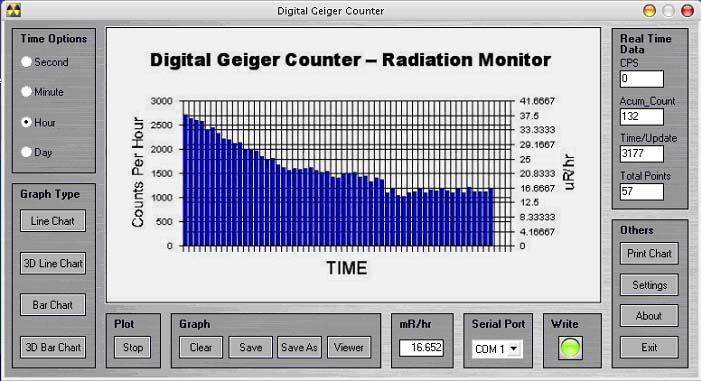
The DMAD also has a true random number generator function.
More information on the DMAD can be found here.
A Geiger Counter's ease of Use?
Ease of Use:
Having a great Geiger counter that is a pain to use is no bargain. Some Geiger counters use a push the button to rotate through menu options to select different modes and ranges. If you read the reviews on these types of Geiger Counters most customers find this type of menu selection frustrating.
The engineers at Images SI Inc. looked at this modality and decided against it.
Look at figure 24, all models can be easily selected from the front panel switches. Another option that received bad reviews are membrane switches. The advantage of membrane switches are they allow a flat profile on the Geiger counter case. The disadvantage(s), the microcontroller needs to see the key press when it is pressed or the option pressed is not initiated. And they don't have the positive feel of a standard switch closure.
You want a Geiger counter that is easy and intuitive to use. Not one that requires you to reference a manual to make mode selections.
Warranty:
The standard warranty is one year parts and labor for any factory defects. An exception to the warranty is the GM tube which is fragile and could be broken easily if not handled properly.
A Quick Recap
Let's review the options covered in this paper.
- Determine your interest and application.
- What radiation do you need to detect.
- Geiger Counter Accuracy. Can it be NRC Certified?
- Digital or Analog - Imperial/Metric or Both
- Range
- Data Logging and Radiation Charting Software
- Ease of Use
- Working within your budget
- Warranty
Disclaimer:
I could not obtain permission from other manufacturers to list their Geiger Counters in this Buyer's Guide. While manufacturers have no problem with listing the positive aspects of their products, they are concerned with the specific not-so-positive aspects. So I was limited in what products I could show and list. Since I work for Images SI Inc. I have full access and permission to use their products and pictures. The information provided here are general guidelines for purchasing a Geiger counter, and are applicable to all Geiger counters.
Tell me what you think. Good, Bad or Ugly. This document will be updated and expanded. If there is something you want to know about that is missing tell me. I will do my best to add relevant material that you want to read. Send all comments to: sales@imagesco.com . For a Printable version of this information click here


